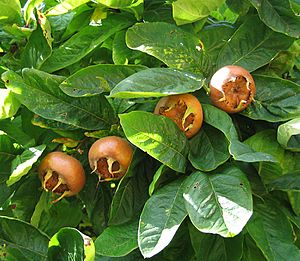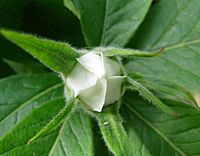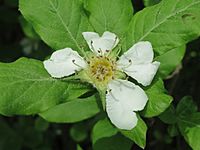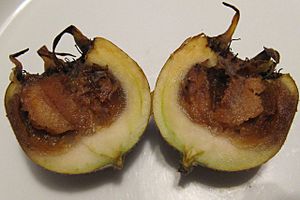Medlar facts for kids
Quick facts for kids Medlar |
|
|---|---|
 |
|
| Foliage and fruit | |
| Conservation status | |
| Scientific classification | |
| Genus: |
Mespilus
|
| Species: |
germanica
|
The medlar (scientific name: Mespilus germanica) is a large shrub or small tree. It belongs to the rose family, just like apples and pears! People have grown medlar trees for their fruit since Roman times. The fruit is usually ready to eat in winter. It needs a special process called bletting to become soft and tasty. You can eat medlar fruit raw or cook with it. Sometimes, if the medlar plant is grouped with hawthorns, its scientific name changes to Crataegus germanica.
Contents
Discovering the Medlar Tree
The medlar tree is a deciduous plant, meaning it loses its leaves in autumn. It can grow up to 8 meters (about 26 feet) tall, but it's often shorter and looks more like a bush. Medlar trees live for about 30 to 60 years. Their bark is grayish-brown with deep cracks.
Wild medlar plants often have thorns and are usually between 1.5 and 4 meters (5 to 13 feet) tall. The types grown by people usually have fewer thorns or none at all. A medlar tree often has a rounded shape with branches that hang down. Its trunk can be a bit bumpy. Most trees are 1 to 6 meters (3 to 20 feet) tall. The roots spread out wide and have many branches.
The wood of the medlar tree is very hard and has a fine texture. It has a light pinkish-white outer layer and a brownish center. You can clearly see its yearly growth rings.
Leaves and Flowers
In winter, the medlar tree has pointed, oval-shaped buds that are about 5 millimeters (0.2 inches) long. Its leaves are dark green and shaped like an oval, about 8 to 15 centimeters (3 to 6 inches) long. The underside of the leaves is fuzzy. In autumn, the leaves turn red before they fall off.
Medlar flowers are 2 to 5 centimeters (0.8 to 2 inches) wide. They grow alone at the end of short side branches. Each flower has five long, narrow sepals (leaf-like parts under the petals) and five white or light pink petals. Medlar trees flower quite late in the year, usually in May or June.
The flowers have both male and female parts, and bees help to pollinate them. Usually, the plant can pollinate itself. After pollination, the flower turns into a flat, reddish-brown, fuzzy fruit with juicy flesh. The fruit is a pome, which is a type of fruit like an apple. It's 2 to 3 centimeters (0.8 to 1.2 inches) wide. The sepals stay on the fruit, making it look like it has a hollow top. The fruits of cultivated trees can be even bigger, from 3 to 8 centimeters (1.2 to 3.1 inches) wide.
How Medlars Reproduce
Wild medlar trees usually reproduce by making seeds. These seeds can sprout up to 20 months later. Animals like birds, squirrels, and deer help spread the seeds. Some types of medlar trees don't produce seeds and can only be grown from cuttings or by grafting.
Medlar Family Tree
For a long time, M. germanica was the only known type of medlar. But in 1990, a new type called M. canescens was found in North America. The loquat, also known as the 'Chinese medlar', is not as closely related to the medlar as other plants like hawthorn.
Different Kinds of Medlars
There are 23 different kinds of M. germanica, including wild types, garden plants, and those from different places. Some of these include:
- Mespilus germanica var. gigantea: This kind has very large fruits.
- Mespilus germanica var. abortiva: Its fruits don't have seeds.
- Mespilus germanica var. argenteo-variegata: This is an ornamental plant with white and green leaves.
- Mespilus germanica var. aureo-variegata: This is another ornamental plant with yellow and green leaves.
Some popular types of medlars grown for their fruit are 'Hollandia', 'Nottingham', and 'Russian'. The 'Dutch' type has large fruits. 'Royal' medlars produce a lot of fruit. 'Early medlar' fruits ripen quickly and taste good. The 'Seedless' type has fruits without seeds, but they are not as good quality.
The 'Nottingham' medlar has won an award called the Royal Horticultural Society's Award of Garden Merit.
What's in a Name?
The Latin word germanica means 'German'. However, the medlar tree naturally grows in other parts of the world, not just Germany.
Where Medlars Grow
Scientists believe the medlar tree originally came from the southeastern part of the Balkan peninsula, Asia Minor (like the Armenian highlands), the Caucasus mountains, Crimea, and northern Iran. You can also find it in southeastern Europe, especially along the Black Sea coasts of Bulgaria and Turkey.
Medlar trees like temperate and sub-Mediterranean climates. This means they prefer warm summers and mild winters. Temperatures of 18 to 20°C (64 to 68°F) are good for their growth. They can even handle cold temperatures down to -20°C (-4°F). Wild medlars have been seen in dry areas with about 700 mm (27.5 inches) of rain each year. They grow at heights from sea level up to 1,100 meters (3,600 feet).
The tree can grow in many types of soil. It prefers fresh, well-drained soils that are a bit clay-like, with a pH between 6 and 8. It is rare in southern Europe and is sometimes found growing wild in parts of southeast England.
Medlar Tree Health
Medlar trees are usually quite strong and don't often get sick or attacked by insects.
However, in places where many medlars are grown, tiny butterfly larvae called Lithocolletis blancardella can cause damage to the leaves. Also, in rainy years, a fungus called Monilia fructigena can be a problem. It makes brown spots on the fruit, which then rot completely.
Medlar trees can also get powdery mildew from a fungus called Podosphaera clandestina. This can make leaves and buds wilt. Another fungus, Entomosporium mespili, causes spots on the leaves. Like other plants in the rose family, medlars can get a serious disease called fire blight, caused by a bacteria called Erwinia amylovora.
Growing Medlar Trees
People might have been growing medlar trees for as long as 3,000 years! The ancient Greeks knew about them around 700 BC, and the Romans started growing them about 200 BC. Medlars were an important fruit during Roman and medieval times. But by the 1600s and 1700s, other fruits became more popular, so fewer people grow medlars today.
Medlar fruits are special because they become ready to eat in winter. This makes them a great choice for gardeners who want fresh fruit all year round.
How Medlars are Grown
To grow more medlar trees, people often use a method called grafting. This means attaching a part of a medlar tree onto another plant, like a hawthorn, mountain ash, pear, or quince tree. Grafting helps the medlar tree grow better in different types of soil.
Grafted medlar trees start producing a lot of fruit about 6 to 7 years after grafting. They continue to produce fruit for 20 to 25 years. Each tree can produce between 30 and 70 kilograms (66 to 154 pounds) of fruit per year, depending on the type and age of the tree.
It's not usually recommended to graft medlars onto young medlar plants because they grow slowly. Giving the trees enough water and fertilizer can help them grow well in orchards. If you trim the branches that produced fruit after the harvest, it helps new fruit-bearing branches grow.
Using Medlar Fruits
When medlar fruits are first ripe, they are hard and sour. They become edible after they soften, a process called "bletting". This can happen after a frost or by storing them for a long time. Bletting reduces the sourness and increases the sugar content.
Once the fruit starts to soften, its skin quickly becomes wrinkled and turns dark brown. The inside turns soft, like apple sauce. This might look like the fruit has gone bad, but that's how it's supposed to look when it's ready to eat!
What Can You Make with Medlars?
After bletting, you can eat the fruit raw, sometimes with sugar and cream. Some people say it's an "acquired taste," meaning you might need to try it a few times to like it. You can also use medlars to make jelly. Another popular use is "medlar cheese," which is a thick spread similar to lemon curd, made with the fruit pulp, eggs, and butter.
Unripe medlar fruits have a lot of tannin, which is a substance used for tanning leather. Tannin can also help make wine clearer. In Germany, a strong drink called schnapps is made from medlar fruit. Sometimes, "medlar tea" is mentioned, but this is usually made from goji berries, not M. germanica.
Scientists have even used oil from medlar seeds to make biodiesel, which can be used as fuel for engines without needing changes to the engine. Medlar leaves have been used to create a special material that can remove heavy metals from water.
Also, tiny silver nanoparticles made from medlar extract have shown promise in fighting certain types of bacteria that are resistant to medicines.
Healthy Medlars
Medlar fruits are full of good things for you, like potassium, calcium, phosphorus, magnesium, and iron.
They also contain different natural plant chemicals called phytochemicals. These chemicals can vary depending on the type of medlar, how ripe the fruit is, and how it's stored. The fruits are especially rich in certain natural flavors and acids. The balance of amino acids, sugars, and organic acids gives the fruit its taste.
Because of their natural properties, medlar fruits have been used in traditional medicine to help with things like urination and to tighten tissues.
Here's a look at some of the nutrients found in medlar fruit:
| Time Frame | L-ascorbic acid | Glucose | Fructose | Potassium | Calcium |
|---|---|---|---|---|---|
| Early 1984 | 1.64 mg/l | 53.75 mg/l | 37.31 mg/l | 47.20 ppm | 4.70 ppm |
| End 1984 | 1.54 mg/l | 61.74 mg/l | 70.06 mg/l | 43.00 ppm | 4.50 ppm |
| Early 1985 | 2.64 mg/l | 43.50 mg/l | 35.70 mg/l | 48.90 ppm | 5.20 ppm |
| Late 1985 | 1.41 mg/l | 60.30 mg/l | 60.50 mg/l | 46.1 ppm | 5.00 ppm |
The amount of fructose (a type of sugar) in the fruit increases as it develops. The amount of tannin and fruit acids, like ascorbic acid (Vitamin C), goes down as the fruit ripens. In ripe fruit, glutamate and aspartate are the main amino acids.
Images for kids
See also
 In Spanish: Níspero europeo para niños
In Spanish: Níspero europeo para niños
- Chaenomeles speciosa
- Crabapple
- Pseudocydonia
- Sorbus













